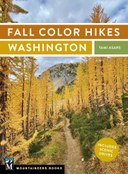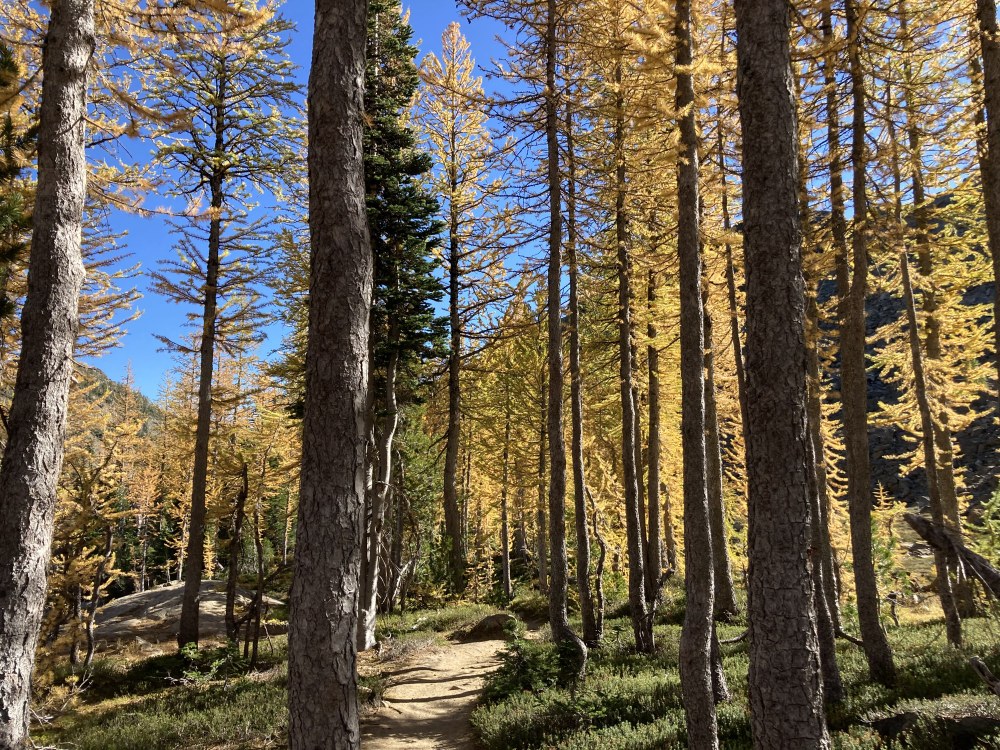
Crisp days and bright fall foliage call hikers out onto the trails each autumn, but few trees draw crowds like our much-loved larches. Located primarily on the sunny eastern slopes of the Cascades, larches are deciduous conifers whose needles turn a rich gold each year. Their stout frames and bristling branches dot hillsides with color each October, and make alpine scenes all the more magical. Read on to learn more about these unique trees and the best hikes to spy them on.
What are Larches?
Though we have many deciduous trees in the northwest, deciduous confers are less commonly spotted. These trees lose their needles each fall, going through the same color changing process as their non-cone bearing brethren. As bright green chlorophyll fades from the needles, other underlying pigments are revealed for a few golden weeks before the needles are lost for the winter.
Not only does the tree save precious resources by losing its needles in winter, but it makes itself less of a target to animals, insects, and other threats. Two types of larches are present in Washington: subalpine larches and western larches. Also known as tamaracks, the larch has become the undisputed favorite of fall hikers.
Subalpine Larches
Also known as: alpine larch, lyall larch, lyall's larch, tamarack, timberline larch, woolly larch
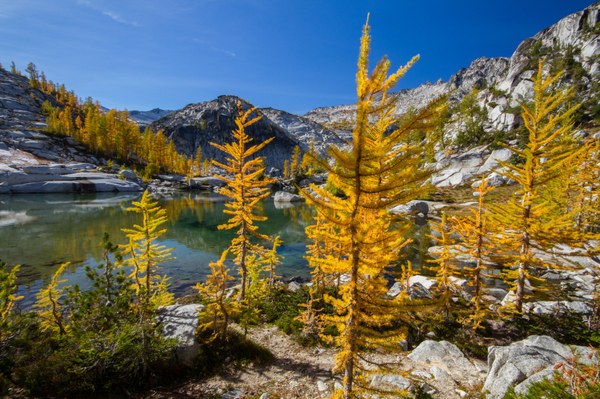 Larches in the Enchantments. Photo by Ida Vincent.
Larches in the Enchantments. Photo by Ida Vincent.
Subalpine larches are typically found in cold, moist, high-altitude locations, generally between 5,8000-9,900 feet of elevation. They are found across the mountain west, but here in Washington they’re present on the eastern slopes of the North Cascades. Referred to as a “pioneer species”, subalpine larches do well in rocky areas where vegetation is limited as well as areas that have seen fire or avalanches. However, they are not a fire-tolerant species as their thin bark is easily damaged. Because of their tendency to grow in sparsely populated areas, it is common to see stands of subalpine larches covering around half an acre.
A long-lived native species, subalpine larches typically live to be 400-500 years old (though some have been aged at 1,000 years!). They don’t start producing cones until they’re 100 years old, and it’s only at 200 years that they begin producing them in large amounts.
This low-growing species averages 40-50 feet tall and 12-24 inches across. The largest subalpine larch ever recorded was right in the North Cascades, at a whopping 95 feet tall and 79 inches across. Many animals feed in their stands, including mountain goats, bighorn sheep, hoary marmot, pika, mule deer, bears, and blue grouse (who rely heavily on their needles). If you see photos of golden larches in large swaths in rocky, high-elevation environments, you’re probably looking at subalpine larches.
Learn more about the subalpine larch in this this resource by the Forest Service.
Western Larch
Also known as: western tamarack, hackmatack.
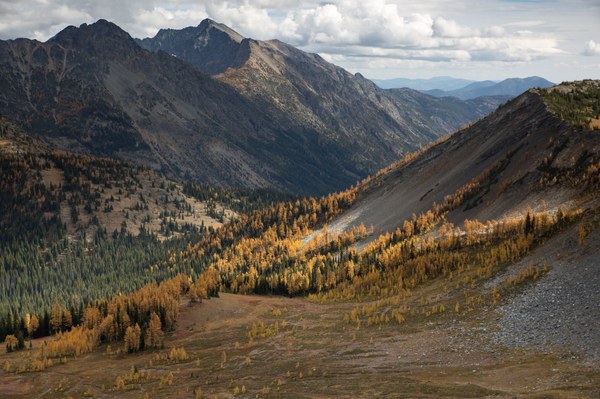 Devils Peak and Robinson Mountain as seen from Slate Peak. Photo by Gabe Purpur.
Devils Peak and Robinson Mountain as seen from Slate Peak. Photo by Gabe Purpur.
This fast-growing cousin of the subalpine larch grows to be 100-180 feet tall, though trees have been reported at over 200 feet and six feet across! They are more triangular in shape and one of the world’s largest larches, making for a stunning sight when they receive their gold each autumn.
Located across the mountain west, Western larches can be found in northeastern Washington, southeastern Washington, and the eastern slopes of the Cascades, where they are happy in cool, moist environments. They grow between 2,000-5,500 feet of elevation; any higher and it’s too cold in the winters, and any lower they don’t receive enough rain.
Western larches are the most fire-resistant tree in its range, thanks to its thick bark and low amounts of resin. This is important, as they thrive in areas that have experienced fire damage (and has limited competition). They are also a long-lived species, averaging around 500 years with some lucky trees surviving for 1,000 years. Western larches provide habitat to many of the animals in the Cascades, and their needles are a favorite for several species of grouse. Unlike the subalpine larch, western larch are rarely found in pure stands, and are frequently seen with fir, pine, and hemlock trees.
Learn more about the western larch with this this resource by the Forest Service.
Where To See Larches
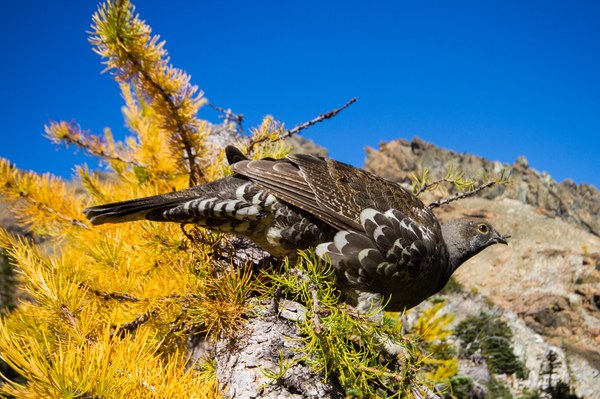 One of the many animals who rely on the larch. Photo by Ida Vincent.
One of the many animals who rely on the larch. Photo by Ida Vincent.
MAPLE PASS LOOP
Location: North Cascades - Highway 20
Mileage: 7.2 miles roundtrip
Elevation Gain: 2,000 feet
This moderate hike offers incredible ridgeline views of wildflowers in the summer and larches in fall! Located at the edge of the North Cascades National Park, you have the chance to see nearby mountains Corteo, Frisco, Goode, Stiletto, Black Peak, and more. If you have a little spare time, take the 0.6-mile roundtrip detour to sparking Lake Ann – you won’t be disappointed.
LAKE INGALLS
Location: Snoqualmie Region - Salmon La Sac/Teanaway
Mileage: 9 miles roundtrip
Elevation Gain: 2600 feet
Located in the stunning Alpine Lakes Wilderness, Lake Ingalls is undoubtedly a show-stopper in fall! You’ll have chance to see the Esmerelda Peaks, Ingalls Peaks, Fortune Pass, and spy glimpses of the Stuart Range. Not to mention stunning views of Mt. Stuart! This is the perfect lake hike for peak lovers any time of year, but autumn larches add an extra dash of magic.
CUTTHROAT PASS
Location: North Cascades – Highway 20
Mileage: 11 miles roundtrip
Elevation Gain: 2300 feet
If you’d like to get some additional mileage in while you admire fall larches, Cutthroat Pass is the way to do it! Offering moderate elevation gain over 10 miles, this trail features creek crossings, impressive views of Black and Fisher mountains, and a beautiful open valley filled with huckleberry and heather. Cutthroat Lake is located at the base of the pass, and is an excellent option if you’re looking for a shorter larch hike in the area.
COLCHUCK LAKE
Location: Central Cascades – Leavenworth
Mileage: 9 miles roundtrip
Elevation Gain: 2100 feet
Colchuck Lake is a local gem just outside of Leavenworth, a perfect day trip if you find yourself in little Bavaria. You’ll travel through dense forest along a wide and well-maintained trail before arriving at the lake itself, large and crystal clear. With Dragontail and Colchuck Peaks looming overhead, this stunning hike is one of the quickest routes to a magical sub-alpine experience.
THE ENCHANTMENTS
Location: Central Cascades – Leavenworth
Mileage: 18 miles one way
Elevation Gain: 6500 feet
One of the most stunning regions in the state, the Enchantments earned its name no doubt in part thanks to its annual golden larches. Subalpine larches flourish in this rocky, otherworldly corner of the Cascades thanks to its alpine environment. There are three ways to access the Enchantments, the easiest being Aasgard Pass via Colchuck Lake. However, keep in mind that accessing the pass is 7 miles one way and 4,400 feet in elevation gain. If you have the time and the gumption, the Enchantments is a fantastic way to experience autumn in the Northwest.
 The Mountaineers
The Mountaineers
 Larches on the Lake Ingalls trail. Photo by Kristina Ciari.
Larches on the Lake Ingalls trail. Photo by Kristina Ciari. 